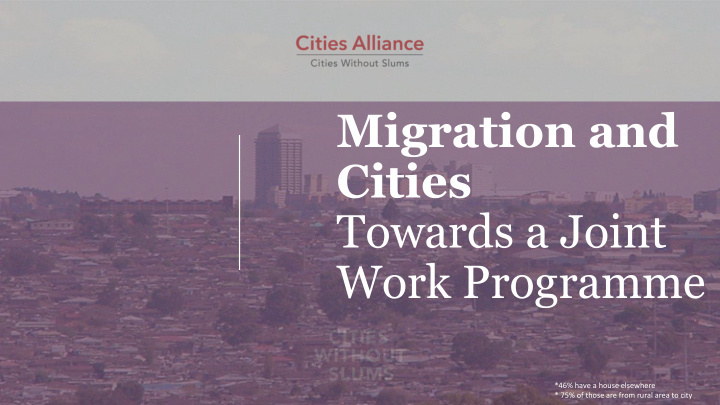



Migration and Cities Towards a Joint Work Programme *46% have a house elsewhere * 75% of those are from rural area to city
What is a Cities and Migration Joint Work Programme? Multi-year partnership focusing on Cities and Migration to deepen institutional What knowledge for strengthened programming for cities Delivery of knowledge products, policy dialogues and strategic TA demonstrations that seek to leverage the collaborative advantage of partnership for Approach cities and improve the quality of programming Partnership Brokering for Advocacy/Dialogue/Campaigns What does the Knowledge Generation Secretariat Coherent Programmatic Framework provide? Funding and Exposure National, regional and city governments Members of the Cities Alliance Who are the Training institutes and academic institutions Partners? Local government associations Urban poor communities Private Sector Other development partners
Facts and Figures Migrants Every 7 person in the world Million Internal Migrants Million Refugees Million Internally Increased of 41% Displaced People between 2000 and 2015 *United Arab Emirates 88% Liechtenstein 63% India 0.4% China 0.1%
Africa is almost as urbanized as India and has as many cities of 1 million people as Europe Share of urban vs. rural population by region, 2016 %, million 637 359 100% = 1,324 511 1,033 1,378 100 90 33 38 80 57 70 75 60 80 82 50 40 67 62 30 43 20 25 20 10 18 0 India SSA China EU LAC North America Cities with >1 million 48 109 52 52 63 48 people Rural Urban
Migration and Internal Growth 5.7% Doubles in 12 years, Nampula Formal and Informal Area 1999 Formal and Informal Area 2015
City Natural Growth and Migration • Mekele City (Ethiopia) 4.9% Population Growth 2.53% Natural Growth 2.34% Migration • Dire Dawa (Ethiopia) 3.2% Population Growth 2.55% Natural Growth 0.7% Migration • Arua (Uganda) 3.8% Population Growth 3.21% Natural Growth 0.6% Migration • Tete (Mozambique) 6.5% Population Growth 2.5% Natural Growth 3.7% Migration
3 Thematic Lenses • Integration and Social Cohesion Potential Role of Secondary Cities • Better linking places of origin and destination •
Integration and Social Cohesion • Low fertility rates high growth economies. • International migration / Refugees • Cultural sensitivity • Diversity • Alienation • Changing nature of city • Migrant transition areas • Growth of nationalist movements
Integration and Social Integration and Social Cohesion cohesion • High fertility rates low growth economies. • Internal/International Migration • Economic sensitivity • Growth of slums • Informal economy • Competition for limited state resources • Conflicts highly localised
Projects promoting Social Cohesion • Project to promote social cohesion among migrant and local youth in communities of Yopougon Municipality in Cote d’Ivoire through basketball. Basketball tournament • Project Youth sensitization on social cohesion components: Rehabilitation of basketball courts Training and stakeholder engagement on social cohesion Basketball training and tournaments Basketball tournament Rehabilitated basketball court
The Potential Role of Secondary Cities Potential Role of Secondary Cities
Economic Structure – Building the Hybrid Economy Lack of Transformative, The Missing Middle : Equitable Economic Growth: Few medium to large companies and large numbers of very small Consistently high GDP growth rates from and informal operations. 2000 to 2010 but the large share of the workforce in vulnerable employment has not changed. 2000 2010 63% 65% 28% Women in Ethiopia are 24% 11% 9% twice as likely to be unemployed as men.
Human Resources 2. Capacity Gaps 1. Distorted Incentives 28% of Need Undermining Good Governance 0 500 1000 1500 2000 2500 3000 3. Inadequate Employment Structure Hierarchy Gaps - Dire Dawa, Ethiopia Current Manpower Model Manpower
A System of Secondary Cities is Important 75% of the world population live in settlement of less than 500,000 people These areas produce less than 40% of global GDP Over 2,400 Secondary Cities Worldwide with populations of less than 750,000 people Nearly 2/3 of them are in Africa and Asia If efficiency of systems of secondary cities increased this could x 3 triple the GDP of many poor cities and rural regions; Countries dominated by one mega city generally have higher levels of regional development disparities, lower levels of national productivity and lower income per capita .
Better Linking Place of Origin and Destination USD 583 Billion – remittances Kenya: 30%-40% of the 600 doctors USD 436 Billion- developing who graduate annually leave the Kenya: 30%-40% of the 600 countries. country Better Linking Place of Origin and Destination doctors who graduate annually leave the country. One additional migrant creates around 1,787.84€a year in additional exports for the country of origin. For every skilled person who returns home, nine new jobs are created in the formal and informal sectors.
Joint Work Programme Migration framework resilient strategic Partnerships planning advocacy transfers knowledge Thank You AFRICA enable collaboration aligned capacities partners members cooperation development innovation learning implementation needs coherence gaps country tools communications technical
Recommend
More recommend